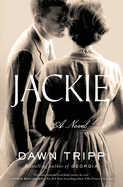
"Memory is wreckage touched in sunlight," Jacqueline Kennedy Onassis muses near the end of Dawn Tripp's luminous fifth novel, Jackie. Often publicly defined by her relationships with U.S. President John F. Kennedy and then wealthy businessman Aristotle Onassis, Jackie was much more than a glamorous appendage for powerful men. Tripp's reflective first-person narration showcases Jackie's many facets: sister, daughter, mother, traveler, voracious intellectual, lover of beauty and elegance. Spanning the decades from 1951 to the mid-1990s, Jackie traces "the evolution of a woman's interior life."
Tripp (Georgia) begins with a brief prologue: a spare, vivid rendering of the moments after JFK's 1963 assassination in Dallas, Tex. She then goes back to the dinner party when Jackie is formally introduced to Jack. Simultaneously annoyed and intrigued, Jackie calls him "six feet of casual stardust." The novel follows their courtship and marriage, the rise of Jack's political career, the births of their two children, and Jackie's life after his death. Although the broad outlines of Jackie's life are public knowledge, Tripp brilliantly blends fiction and fact to fill in the details: Jackie's passions for French art and horseback riding; Jack's restless mind and his multiple affairs; the complicated push-pull of their relationship, beset by personal and political stresses. After Jack's death, Jackie must decide who she will be without him, and Tripp paints a dazzling portrait of a woman growing beyond the myth that often held her captive.
Juxtaposing cinematic scenes and thoughtful interior reflections, Jackie is a beautifully rendered imagining of its subject: a woman of tremendous courage, intellect, wry humor, and grace. --Katie Noah Gibson, blogger at Cakes, Tea and Dreams

